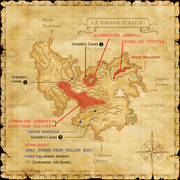|
Job: Warrior Notorious Monster |
 Tumbling Truffle |
| Zone | Level | Drops | Steal | Spawns | Notes |
|---|---|---|---|---|---|
| La Theine Plateau | 19 - 20 |
|
1 | A, L, H 500~600 HP | |
Nyzul Isle
|
1 | A, L, H ??? HP | |||
|
HP = Detects Low HP; M = Detects Magic; Sc = Follows by Scent; T(S) = True-sight; T(H) = True-hearing JA = Detects job abilities; WS = Detects weaponskills; Z(D) = Asleep in Daytime; Z(N) = Asleep at Nighttime; A(R) = Aggressive to Reive participants | |||||

Notes:
- Lottery Spawn from the 3 Poison Funguars around K-6 at the bottom of a ravine. (Can spawn J-7, J-6, or K-6)
- The first Poison Funguar of the three on widescan is the placeholder.
- Note that to get to the spawn point you will need to go down the ramp at H7 and then continue east through some tunnels.
- Killing this NM is required to complete the quest The Miraculous Dale.
- You must kill it in La Theine Plateau for the quest to update; Nyzul Isle doesn't count.
- Respawn time is approx. one hour after defeated. (NB Has been camped for over 4 hours without pop)
- Respawn is about 2 hours
- Killable by: Solo at level 24 (see testimonials)
- Nyzul Isle: The Armoury Crate it leaves behind contains a ??? Headpiece, which may rarely appraise into a Fungus Hat.
- Killing it three times is required for Trial 68 for Pugilists augmentation weapon. Being in a party/alliance with a member that kills it counts.
- Lottery Spawn from the 3 Poison Funguars around K-6 at the bottom of a ravine. (Can spawn J-7, J-6, or K-6)
| Hunt Registry | Elusiveness | Ferocity | Required Scylds | Rewarded Scylds | Evolith | Evolith |
|
2 | 2 | 15 | 5 | |
|
Historical Background
Truffles are fungi of the genus Tuber. They belong to Division Ascomycota (fungi that appear as spheres or sacs; traditional mushrooms belong to Division Basidiomycota). Truffles are highly valued for their taste and as a result are very expensive. Truffles grow in association with trees, usually oaks, beeches, poplars, and hazels. The fruiting body emerges in autumn. Most of the truffles used for food come from Europe or China. A few of the less commonly utilized species reside in the Pacific Northwest of North America. There are two types of truffles: black truffles and white truffles. The chocolate candy truffle is named for its resemblance to the truffle fungi, not for having the truffle as an ingredient.
Tumbling refers to moving in a rolling motion, usually with the implication of moving in an uncontrolled manner. Thus, a tumbling truffle is a truffle that is rolling around (presumably) the hills of La Theine.
